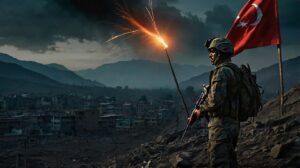
Introduction
Overview
In May 2025, South Asia witnessed a significant escalation in tensions between India and Pakistan, marked by military confrontations and social upheavals. This period has been characterized by heightened military activity along the Line of Control, a surge in rhetoric from both governments, and severe implications for civilian populations on both sides of the border. The atmosphere in the region is charged with a mix of historical grievances, national pride, and a longing for peace, making it a complex and sensitive issue.
Thesis Statement
This article delves into the key military engagements, the socio-political ramifications, and the broader implications of these developments on regional stability. By examining the recent events leading to increased tensions, we aim to provide a comprehensive understanding of the situation and its potential future trajectory.
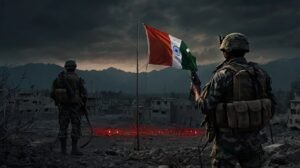
I. Military Escalations: A New Phase in Indo-Pakistani Relations
A. The Pahalgam Attack and Its Aftermath
Incident Overview
On April 22, 2025, a terrorist attack in Pahalgam, Indian-administered Kashmir, resulted in the deaths of 26 civilians, including tourists. The group Kashmir Resistance claimed responsibility, igniting a wave of outrage across India. The attack, targeting a popular tourist destination, highlighted the vulnerability of civilians and the ongoing challenges in ensuring security in the region. The incident was particularly shocking as it came during a time when both nations were attempting to stabilize their relations through dialogue.
The attack not only led to loss of life but also instilled fear among the local populace and tourists alike, affecting the tourism industry, which is vital for the region’s economy. The emotional impact of the attack reverberated through the communities, leading to widespread expressions of grief and anger. Local businesses, which relied on the influx of tourists, faced immediate economic repercussions, heightening the sense of crisis in the area.
Diplomatic Fallout
In the wake of the attack, India accused Pakistan of backing the attackers, leading to a significant breakdown in relations not seen since 2019. The Indian government expressed its frustration through diplomatic channels, urging the international community to take a stand against terrorism emanating from Pakistan. This incident marked a turning point, exacerbating existing hostilities and rekindling fears of a larger conflict.
The incident also reignited debates within India regarding national security policies and the effectiveness of counter-terrorism measures. Public sentiment was heavily influenced by media portrayals of the attack, which often emphasized the need for a strong military response. As a result, political leaders faced increasing pressure from constituents to take decisive action against perceived threats.
B. Operation Sindoor and Pakistan’s Retaliation
India’s Offensive
On May 6, 2025, India launched “Operation Sindoor,” conducting missile strikes on Pakistan and Pakistan-administered Kashmir, targeting alleged terrorist infrastructure. The operation was widely publicized, with Indian officials asserting that it was a necessary response to the Pahalgam attack. The strikes aimed to demonstrate India’s military capabilities and resolve, but they also escalated tensions dramatically. The Indian military vowed to take a tougher stance against cross-border terrorism, and the country was put on high alert.
The operation involved precision strikes on identified targets, and Indian leadership confidently asserted that these actions were in line with their right to self-defense. However, this military engagement raised concerns among international observers about the potential for further escalation and the impact on regional stability.
Pakistan’s Response
In retaliation, Pakistan initiated “Operation Bunyan-ul-Marsoos,” involving missile and drone strikes against Indian military installations. This operation was framed by Pakistan as a defensive measure aimed at safeguarding its sovereignty. The response was met with a mix of criticism and support within Pakistan, as citizens grappled with the implications of military engagement on their daily lives. The Pakistani military’s actions were characterized as a necessary response to defend against what they deemed an act of aggression.
The retaliation included not only missile strikes but also cyber operations aimed at disrupting Indian military communications. Pakistan’s leadership emphasized that they would not tolerate aggression and that their military was prepared for any further escalations.
C. Military Exercises and Civil Defense Preparations
India’s Military Drills
In light of the escalating situation, the Indian Air Force conducted “Exercise Aakraman,” focusing on enhancing offensive capabilities and operational readiness. The exercise involved various military assets and aimed to simulate real-time responses to potential threats. This display of military might was intended to reassure the Indian public and signal to Pakistan that India was prepared for any eventuality.
The military drills showcased advanced technology, including the use of drones and precision-guided munitions, which highlighted India’s growing defense capabilities. However, they also raised alarm bells in Pakistan, leading to an increase in their military preparedness and exercises as well.
Civil Defense Measures
India organized a nationwide civil defense mock drill, “Operation Abhyaas,” to bolster civilian readiness against potential threats. The drill involved simulations of various scenarios, including air raids and terrorist attacks, aiming to prepare citizens for emergencies. While some welcomed these efforts, others expressed concerns that such drills could incite panic and exacerbate tensions in an already volatile environment.
These drills aimed to educate the public on emergency procedures and enhance community resilience. However, the necessity of such preparations reflected the grim reality of the security situation in the region. Many citizens expressed their frustration, feeling that they were caught in the crossfire of political disputes beyond their control.
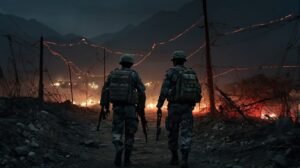
II. Social Unrest and Internal Strife
A. The Murder of Kamal Kaur Bhabhi
Incident Details
On June 9-10, 2025, social media influencer Kanchan Kumari, known online as Kamal Kaur ‘Bhabhi,’ was found strangled in her car outside Adesh Medical University in Bathinda, Punjab. Police arrested two individuals and launched a manhunt for the mastermind, Amritpal Singh. The murder shocked the nation and sparked widespread protests, with calls for justice echoing across social media platforms.
The incident highlighted the dangers faced by public figures, particularly women, in a society grappling with deep-rooted issues of gender inequality and moral policing. Kamal Kaur was known for her bold online presence, often challenging societal norms and advocating for women’s rights. Her murder was not just a crime; it became a symbol of the broader struggles women face in India.
Moral Policing Allegations
The incident has been linked to moral policing, with the influencer’s bold online presence cited as a motive for the crime. Many argued that her lifestyle choices and social media persona challenged traditional norms, leading to backlash from conservative groups. The public outcry highlighted the ongoing struggle between progressive values and conservative ideologies in Indian society.
The murder incited a wave of protests across various cities in India, with activists demanding justice for Kamal Kaur and calling attention to the rampant moral policing targeting women. Social media became a powerful tool for advocacy, with hashtags trending to raise awareness about gender-based violence and the need for reform in societal attitudes.
B. Balochistan Protests and State Response
Protest Outbreak
In March 2025, protests erupted in Balochistan following the suppression of a gathering outside Quetta Civil Hospital. Police forces used batons to disperse families attempting to identify bodies from a train hijacking. The heavy-handed response triggered outrage, leading to widespread demonstrations calling for justice and accountability.
The protests were fueled not only by the incident but also by longstanding grievances regarding governance, development, and human rights violations in Balochistan. Activists demanded greater autonomy and recognition of their rights, highlighting the region’s marginalization by the central government.
Government Actions
Authorities allowed some families to identify bodies but faced criticism for their handling of the situation. The protests underscored long-standing grievances in Balochistan, including demands for greater autonomy and rights. The government’s response to the unrest drew international attention, with human rights organizations calling for investigations into the use of force by security forces.
The handling of the protests highlighted the delicate balance between maintaining law and order and addressing the legitimate concerns of the populace. Many in Balochistan expressed frustration over perceived neglect by the central government, leading to calls for increased political representation and investment in local development.
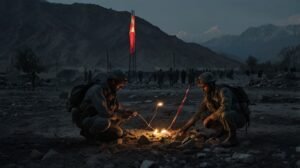
III. Diplomatic and International Reactions
A. Global Concerns and Mediation Efforts
International Calls for De-escalation
Nations including Russia, Turkey, and Azerbaijan urged immediate de-escalation, citing the risks of a regional war. Diplomatic channels were activated, with leaders expressing concern over the potential humanitarian crisis that could arise from continued military confrontations. The international community emphasized the need for dialogue and peaceful resolution to avert further violence.
Global organizations such as the United Nations and regional bodies like the South Asian Association for Regional Cooperation (SAARC) also expressed alarm at the rising tensions and called for restraint from both parties. The geopolitical implications of a conflict between India and Pakistan were recognized as a serious concern for global stability.
Mediation Attempts
Iran emerged as a potential mediator, with diplomatic efforts to broker dialogue between India and Pakistan. Iranian officials expressed willingness to facilitate discussions, highlighting the importance of regional stability. However, skepticism remained on both sides regarding the effectiveness of external mediation, given the historical complexities of the Indo-Pakistani relationship.
Iran’s involvement was seen as a double-edged sword; while it could potentially lead to productive dialogue, it also raised concerns about external influences complicating the situation. The success of mediation efforts relied heavily on the willingness of both India and Pakistan to engage constructively.
B. Impact on Regional Stability
Economic Disruptions
The conflict led to the suspension of visa services, flight diversions, and disruptions in trade and tourism, affecting regional economies. Businesses reliant on cross-border trade faced significant losses, and the tourism sector, particularly in Kashmir, suffered a sharp decline as safety concerns deterred visitors. The economic fallout raised alarms about the long-term implications for both nations, with many citizens expressing frustration over the impact of political tensions on their livelihoods.
The economic ramifications of the conflict extended beyond immediate disruptions. Many communities that depended on tourism for their livelihood faced uncertainty, and local businesses struggled to cope with the loss of income. The situation highlighted the interconnectedness of regional economies and the potential for conflict to have far-reaching consequences.
Security Concerns
The military confrontations raised alarms about the potential for a full-scale war, with implications for regional and global security. Analysts warned that continued escalation could draw in neighboring countries and disrupt the fragile balance of power in South Asia. The threat of nuclear confrontation loomed large, prompting calls for urgent measures to prevent further escalation.
International observers expressed concerns that military confrontations could lead to a miscalculation on either side, triggering a conflict that would have devastating consequences for millions of people. The potential for civilian casualties and humanitarian crises further underscored the urgency of diplomatic efforts to de-escalate tensions.
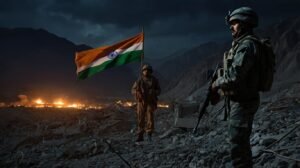
IV. Looking Ahead: Prospects for Peace and Stability
A. Challenges to Peace
Deep-Rooted Hostilities
Historical grievances and territorial disputes continue to fuel tensions between India and Pakistan. The Kashmir conflict, which has persisted for decades, remains a flashpoint in bilateral relations. Nationalistic sentiments on both sides complicate efforts to foster dialogue and reconciliation, as leaders often use anti-India or anti-Pakistan rhetoric to rally domestic support.
The narratives surrounding Kashmir are deeply ingrained in both societies, often reinforced by historical events and political actions. This historical baggage complicates the peace process, making it challenging for leaders to find common ground and implement lasting solutions.
Trust Deficit
A lack of trust and communication channels hampers efforts to resolve conflicts peacefully. Previous attempts at dialogue have often been derailed by incidents of violence or political upheaval. The absence of a consistent framework for engagement leaves both nations vulnerable to miscalculations that could lead to further conflict.
Efforts to rebuild trust have been hindered by ongoing military posturing and political rhetoric. The lack of confidence-building measures further exacerbates tensions, as both sides remain cautious about engaging in dialogue without assurances of goodwill.
B. Opportunities for Dialogue
Track II Diplomacy
Informal dialogues and people-to-people exchanges can build trust and pave the way for formal negotiations. Initiatives that promote cultural exchanges, academic collaborations, and joint humanitarian projects can help bridge the gap between communities and foster understanding. Such efforts may lay the groundwork for more substantive dialogue at the governmental level.
Track II diplomacy has the potential to create a more conducive environment for formal negotiations. By fostering relationships between citizens and civil society organizations, both countries can work towards building a foundation of trust that could facilitate more significant diplomatic breakthroughs.
International Support
Global powers can play a constructive role in facilitating dialogue and providing incentives for peace. The involvement of neutral parties in mediating discussions can help create a conducive environment for negotiations. Pressure from the international community to adhere to human rights standards and respect for sovereignty can also encourage both nations to engage in meaningful dialogue.
International actors can offer economic and political incentives for both India and Pakistan to engage in peace talks. By creating a framework for cooperation, global powers can help mitigate the risks of conflict and promote stability in the region.
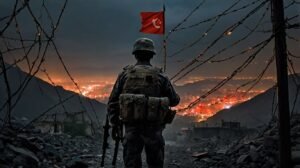
V. The Role of Civil Society and Media
A. Grassroots Movements and Advocacy
Building Bridges
Civil society organizations in both India and Pakistan have been instrumental in fostering dialogue between communities. Grassroots movements that emphasize peacebuilding, reconciliation, and mutual understanding have emerged, focusing on shared cultural heritage and common interests. These organizations often work to counteract the narratives propagated by state media and political leaders.
Through workshops, seminars, and cultural exchanges, civil society groups aim to cultivate relationships between citizens from both nations. These efforts are crucial in humanizing the “other” and dismantling stereotypes that perpetuate division.
The Role of Women in Peacebuilding
Women’s organizations have played a pivotal role in peace advocacy, often taking the lead in grassroots movements. Recognizing the unique challenges faced by women in conflict situations, these groups focus on addressing issues such as gender-based violence and social injustice. By empowering women to participate in peace processes, they contribute to a more inclusive approach to conflict resolution.
B. The Media Landscape
Media’s Influence on Public Perception
The media plays a critical role in shaping public perception of the conflict. In both India and Pakistan, media outlets often reflect nationalistic sentiments, which can exacerbate tensions. Sensationalist reporting and biased narratives can polarize public opinion and hinder efforts for reconciliation.
However, responsible journalism can also serve as a tool for peace. Media outlets that prioritize accurate reporting and diverse perspectives can help promote understanding and empathy between the two nations. Initiatives that encourage cross-border journalism and collaborations can pave the way for more nuanced discussions.
Social Media as a Double-Edged Sword
Social media has emerged as a powerful platform for activism and advocacy, allowing individuals to express their opinions, share experiences, and mobilize communities. While it provides a space for dialogue and awareness, it can also amplify hate speech and misinformation. The rapid spread of unverified information can further inflame tensions, making it essential for individuals to critically assess the content they encounter.
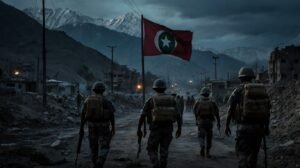
VI. Economic and Humanitarian Implications
A. Economic Impact of Conflict
Trade Disruptions
The ongoing conflict has led to significant disruptions in trade between India and Pakistan. Previously, both nations engaged in various trade agreements, benefiting from cross-border commerce. However, the escalation in military confrontations has prompted a halt to many of these agreements, causing substantial economic losses.
Industries that relied on the movement of goods across the border have been particularly hard hit. Farmers in Punjab, for example, faced difficulties in exporting their produce to Pakistani markets, resulting in financial strain for many families. The economic interdependence that once characterized relations has been replaced by a climate of uncertainty and fear.
Humanitarian Concerns
The human cost of the conflict extends beyond military engagements. Civilians in conflict zones face daily challenges, including displacement, loss of livelihood, and limited access to essential services. The humanitarian situation in regions like Kashmir becomes precarious, with families living in constant fear of violence and instability.
International humanitarian organizations have called for increased support to address the needs of affected populations. Access to healthcare, education, and basic necessities has been disrupted, prompting calls for urgent intervention and aid.
B. The Role of International Organizations
Humanitarian Aid
International organizations such as the United Nations and various non-governmental organizations (NGOs) have been active in providing humanitarian assistance to those affected by the conflict. Initiatives aimed at delivering food, medical supplies, and psychological support have been implemented to alleviate the suffering of civilians caught in the crossfire.
Efforts to raise awareness about the plight of affected communities are critical in garnering international support. Advocacy campaigns that highlight the humanitarian consequences of the conflict can encourage governments and organizations to take action.
Diplomatic Initiatives
International organizations also play a vital role in facilitating diplomatic initiatives aimed at de-escalation. By providing a neutral platform for dialogue, they can help bridge the gap between India and Pakistan. The involvement of international mediators can lend credibility to peace negotiations and encourage both sides to engage constructively.
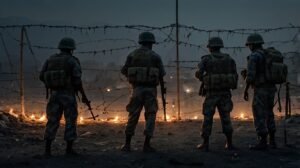
VII. Looking Ahead: Prospects for Peace and Stability
A. Challenges to Peace
Deep-Rooted Hostilities
Historical grievances and territorial disputes continue to fuel tensions between India and Pakistan. The Kashmir conflict, which has persisted for decades, remains a flashpoint in bilateral relations. Nationalistic sentiments on both sides complicate efforts to foster dialogue and reconciliation, as leaders often use anti-India or anti-Pakistan rhetoric to rally domestic support.
The narratives surrounding Kashmir are deeply ingrained in both societies, often reinforced by historical events and political actions. This historical baggage complicates the peace process, making it challenging for leaders to find common ground and implement lasting solutions.
Trust Deficit
A lack of trust and communication channels hampers efforts to resolve conflicts peacefully. Previous attempts at dialogue have often been derailed by incidents of violence or political upheaval. The absence of a consistent framework for engagement leaves both nations vulnerable to miscalculations that could lead to further conflict.
Efforts to rebuild trust have been hindered by ongoing military posturing and political rhetoric. The lack of confidence-building measures further exacerbates tensions, as both sides remain cautious about engaging in dialogue without assurances of goodwill.
B. Opportunities for Dialogue
Track II Diplomacy
Informal dialogues and people-to-people exchanges can build trust and pave the way for formal negotiations. Initiatives that promote cultural exchanges, academic collaborations, and joint humanitarian projects can help bridge the gap between communities and foster understanding. Such efforts may lay the groundwork for more substantive dialogue at the governmental level.
Track II diplomacy has the potential to create a more conducive environment for formal negotiations. By fostering relationships between citizens and civil society organizations, both countries can work towards building a foundation of trust that could facilitate more significant diplomatic breakthroughs.
International Support
Global powers can play a constructive role in facilitating dialogue and providing incentives for peace. The involvement of neutral parties in mediating discussions can help create a conducive environment for negotiations. Pressure from the international community to adhere to human rights standards and respect for sovereignty can also encourage both nations to engage in meaningful dialogue.
International actors can offer economic and political incentives for both India and Pakistan to engage in peace talks. By creating a framework for cooperation, global powers can help mitigate the risks of conflict and promote stability in the region.
Conclusion
The recent military escalations and social unrest between India and Pakistan underscore the fragile state of bilateral relations. While the path to peace is fraught with challenges, sustained diplomatic efforts and international support are crucial for achieving long-term stability in the region. The situation remains dynamic, and the choices made by both governments will significantly influence the future trajectory of relations.
This analysis highlights the importance of addressing underlying issues while promoting dialogue and cooperation. Both India and Pakistan must recognize the necessity of peaceful coexistence, as the consequences of conflict extend beyond borders, impacting millions of lives.
As we continue to monitor developments in this critical region, it is imperative to advocate for peaceful resolutions and foster understanding among communities. The future of South Asia hinges on the ability of its leaders and citizens to navigate the complexities of their shared history and work towards a more harmonious relationship.
For more insights into global economic trends and their implications, visit zaroraterishta.com
10 Key FAQs
-
What triggered the May 2025 crisis?
The Pahalgam terror attack (26 civilians killed) led to Indian strikes on Pakistan-administered Kashmir, prompting Pakistani retaliation. -
What were the military operations?
-
India’s Operation Sindoor (missile strikes on “terror camps”)
-
Pakistan’s Operation Bunyan-ul-Marsoos (drone/missile counterstrikes)
-
How close did this come to full-scale war?
Closest since 2019, with both nuclear powers conducting live-fire drills near the border and recalling diplomats. -
What’s the Balochistan connection?
Protests erupted after police suppressed families identifying bodies from a train hijacking, exposing Pakistan’s internal tensions. -
Who was Kamal Kaur Bhabhi?
A murdered Indian social media influencer whose death sparked nationwide protests against moral policing. -
How did the international community react?
Russia/Turkey called for de-escalation; Iran offered mediation while the UNSC held emergency sessions. -
What’s the economic impact?
-
Suspended India-Pak trade ($2B annual commerce halted)
-
Kashmir tourism collapsed (75% cancellations post-Pahalgam)
-
Are there still peace prospects?
Track II diplomacy continues through backchannels, but mutual distrust and election-year politics hinder progress. -
What’s the Kashmir death toll?
UN estimates 500+ casualties (military/civilian) since January 2025 – highest in 5 years. -
Could this go nuclear?
Experts rate risk at “Danger Zone” (Arms Control Association), though both sides maintain no-first-use policies…for now.
